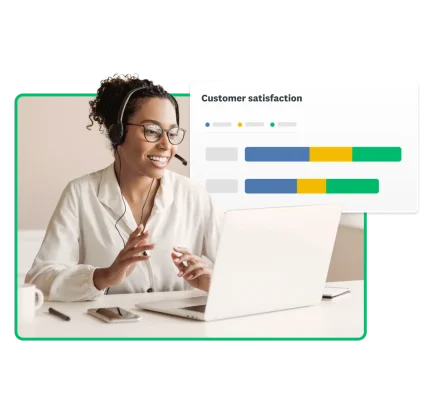The complete guide to the 5 service quality dimensions
Discover how to improve the top five service quality dimensions, such as reliability and responsiveness, in our guide.

Delivering top-notch service isn’t just desirable; it’s essential. But how do you know whether your service hits the mark?
That’s where the five dimensions of service quality come in. These five key pillars of service quality – tangibility, reliability, responsiveness, assurance and empathy – are the building blocks of exceptional customer service. Let’s break them down and explore how to use them to improve your customer experience (CX) strategy.
The 5 service quality dimensions explained

Service quality refers to how well a company meets customer expectations. Delivering high-quality customer service is essential for building loyalty and improving customer advocacy.
The five dimensions of service quality come from the SERVQUAL framework. The SERVQUAL model helps businesses understand the difference between what customers expect and what they experience.
Read on to discover the five service quality dimensions and actionable strategies to improve each.
1. Tangibility
Tangibility is the visible aspects of a business, including its facilities, staff and materials. Tangibility plays a crucial role in shaping customer expectations and perceptions of quality. A polished, professional appearance signals that a company values customer comfort and satisfaction.
Common attributes that contribute to tangibility are:
- Cleanliness: Maintained facilities and regular upkeep
- Professionalism: Well-groomed and presentable employees
- Design: Clear, visually appealing and easily accessible marketing materials
For example, it’s likely that a high-end retailer will maintain a stylish ambiance. They will neatly arrange clothing displays and offer an online store that mirrors the in-store experience.
How to improve tangibility:
- Keep your space clean and organised.
- Make sure that employees are dressed professionally and approachable.
- Ensure that communication materials are clear, visually appealing and easy to access.
2. Reliability
Reliability is about delivering what you promise. It is critical in terms of fostering customer trust, especially in industries where precision and timing are essential.
Key indicators and attributes of reliability include:
- Timeliness: On-time delivery rates
- Consistency: Adherence to service commitments
- Dependability: Accuracy in issue resolution
For example, a food delivery service shows reliability when it delivers quickly – a factor that research shows is a top priority for consumers.
How to improve reliability:
- Set clear service expectations and stick to them (e.g. shipping delivery windows).
- Regularly monitor service delivery performance to ensure accuracy and timeliness.
- Resolve issues as they arise.
3. Responsiveness
Responsiveness means offering fast, attentive service to customers. This is especially crucial today, when 80% of consumers expect a response within one business day.
Key indicators and attributes of responsiveness are:
- Speed: Average response times to enquiries
- Attentiveness: Reducing customer waiting times
- Proactive communication: Following up with updates or helpful information
For example, in a restaurant, staff promptly attend to diners’ requests, even during peak hours. Delayed service, by contrast, could lead to frustration and a less positive perception.
How to improve responsiveness:
- Train your team to respond quickly and clearly to customer needs.
- Create a comprehensive FAQ page to help customers find answers quickly and independently.
- Increase staffing during busy service windows to reduce waiting times.
4. Assurance
Assurance is the ability to gain customer trust and establish credibility. Customers expect businesses to be the experts in the service they deliver.
Common attributes of assurance include:
- Expertise: Credentials, certifications and in-depth product knowledge
- Credibility: Positive customer testimonials
- Courtesy: Polite, respectful and empathetic interactions
For example, customer success reps demonstrate assurance by addressing customer needs.
How to improve assurance:
- Offer regular employee training and certification programmes.
- Showcase customer testimonials on your website.
- Develop comms guidelines to ensure consistent customer outreach.
5. Empathy
Empathy means showing care and compassion, and giving personal attention, to customers. It’s about treating them as people rather than just transactions. Empathy plays a pivotal role in building loyal, long-term customer relationships.
Defining traits of empathy include:
- Customer feedback scores concerning service interactions (e.g. Customer Satisfaction Score)
- Repeat customer rates
- The frequency of personalised service interactions
For example, a healthcare provider who takes the time to understand each patient’s concerns demonstrates empathy. This helps patients feel valued and understood.
How to improve empathy:
- Train employees to practise active listening and tailor responses to individual customer needs.
- Leverage customer feedback to identify and address unique challenges.
- Share customer insights across teams to build a company-wide understanding of their experiences.
Launch a customer service survey in minutes
Get started with our easy-to-use Customer Service Template.
What is service quality and why should we measure it?
Service quality is how well a service team meets or exceeds customer expectations. It differs from product quality since it focuses on the intangible aspects of service delivery. These aspects include staff efficiency, courtesy and responsiveness.
For example, coffee shop staff greet customers by name and remember their usual order. This friendly, personalised service makes customers feel valued. It may encourage them to tell friends about the experience, improving word of mouth.
Why measuring service quality is important
- It helps you understand customer expectations: Measuring service quality helps you identify how well your business meets or exceeds customer needs.
- It identifies strengths and weaknesses: Regular assessments of service quality allow you to pinpoint areas where your business excels and areas that need improvement.
- It drives competitive advantage: Companies that measure and improve their service quality are better positioned to stay ahead of competitors, differentiating their brand in the marketplace.
7 ways to measure the 5 dimensions of service quality
No. 1: Gather feedback across the customer journey
To understand the customer experience, collecting ongoing feedback at every stage of the customer lifecycle is essential. Regularly capturing real-time feedback helps pinpoint which touchpoints positively or negatively affect service quality.
Use in-app surveys, post-interaction feedback and follow-up emails to gather insights after key moments such as support interactions. By gathering customer insights across the journey, you can make informed improvements and ensure service consistency.
No. 2: Service quality surveys and questionnaires
Service quality surveys and questionnaires can measure the dimensions of service quality.
Here are a few examples of service quality surveys and questionnaires by dimension:
- Tangibility: “Were our facilities clean and inviting?”
- Reliability: “Did we deliver on our promises?”
- Responsiveness: “How satisfied are you with the speed of our service?”
- Assurance: “How confident were you in the knowledge of our staff?”
- Empathy: “Did you feel valued during your interaction with us?”
Timing plays a key role in collecting actionable feedback. The best times to send these surveys include:
- Immediately after a purchase or service interaction
- After onboarding or resolving a support issue
- Ongoing, to track changes in customer perceptions over time
No. 3: Track quantitative service delivery metrics
Focusing on quantitative service delivery metrics helps businesses measure how well service is delivered. These metrics can provide tangible insights into how consistently your service meets established standards and expectations.
Some key quantitative service delivery metrics to track include:
- On-time delivery rates: The percentage of orders or services delivered on time. High rates indicate reliability and commitment to promises.
- Error rates: The number of errors or issues per order or service. Lower error rates show effective service management and high-quality delivery.
- Order accuracy: How often are the correct items or services provided to customers? This metric directly ties into reliability and the fulfilment of promises made.
By closely monitoring these quantitative service delivery metrics, you can:
- Identify performance trends
- Ensure that services are meeting consistency standards
- Take proactive action when error rates increase or on-time deliveries decrease
Learn more about qualitative vs. quantitative research and when to use each method.
No. 4: Establish a Net Promoter Score® programme
Net Promoter Score (NPS) is a powerful metric tracking customer satisfaction and loyalty. It reveals how likely customers are to recommend your business to others.
NPS categorises customers as promoters (those who recommend your services) and detractors (those who don’t). By analysing the reasons behind these ratings, such as long call centre waiting times, businesses can pinpoint and address specific service issues.
To learn how to establish an effective Net Promoter Score programme, read our complete guide to NPS.
Greyhound drove a 15-point jump in NPS
See how Greyhound boosted NPS with fast survey insights by using SurveyMonkey Enterprise and Salesforce.
No. 5: Track your Customer Effort Score (CES)
Customer Effort Score (CES) is another important metric that uncovers customer friction points. CES measures how easy or difficult it is for customers to engage with your company.
The standard CES question is:
- To what extent do you agree with the following statement? [Company] made it easy for me to handle my issue.
CES is best used after customer interactions, such as a support call or website purchase. Analysing CES feedback reveals common pain points, such as long waiting times or confusing processes. Additionally, it helps you prioritise changes that will reduce customer effort.
For more information about CES, please check out our comprehensive guide to Customer Effort Score.
No. 6: Measure your First Contact Resolution (FCR) ratio
First Contact Resolution (FCR) measures how well issues are resolved during a customer’s first interaction. A higher FCR rate indicates a service team’s ability to resolve problems without follow-up.
To improve your FCR rate:
- Give service representatives the appropriate tools and resources.
- Offer multiple communication channels (phone, chat, email).
- Measure and track FCR vs. those requiring multiple responses.
Related reading: Top customer service metrics explained.
No. 7: Anticipate future trends with leading metrics analysis
Leading metrics analysis focuses on tracking data that can indicate future shifts in service quality. These metrics offer early signals of potential issues, allowing businesses to adapt proactively.
Examples of leading metrics include:
- Customer churn rates: The rate at which customers leave your service.
- Repeat purchase rates: How often customers return to buy again.
- Support ticket trends: The volume and types of support requests over time.
Once you’ve established your service quality measurement framework, you’ll need reliable data from a representative customer sample in order to track these metrics effectively. Learn how to create a random sample using Excel to ensure that your service quality measurements are statistically sound and unbiased.
10 quick tips to improve the service quality you deliver
Improving service quality requires a proactive approach and a commitment to consistently meeting or exceeding customer expectations. Here are 10 quick tips to help elevate your service and ensure a positive experience for every customer.
- Regularly collect customer feedback: Regularly ask customers for their opinions about your service to understand their needs and identify areas for improvement.
- Invest in employee training: Equip your employees with the necessary skills and knowledge to provide excellent service. Get started with an employee training survey template.
- Set clear service quality standards and goals: Establish clear expectations for service quality that everyone in your organisation can aspire to.
- Monitor performance: Regularly evaluate your team’s performance to identify strengths and improvement areas. See how your organisation can get started with a performance review survey.
- Build a culture of continuous improvement: Encourage a company-wide commitment to continuous improvement by promoting feedback loops and celebrating progress.
- Personalise service offerings: Tailor your services to meet customer needs, demonstrating that you understand their preferences and value their business.
- Implement quality assurance checks: Conduct periodic checks to ensure that your service meets established standards.
- Empower employees to make decisions: Allow employees to handle customer issues without always needing managerial approval.
- Respond promptly to customer enquiries: Always address customer questions or concerns quickly.
- Foster positive relationships with customers: Build rapport by providing friendly, courteous service.
Service quality dimension FAQs
- What is the SERVQUAL model?
- What is the RATER framework?
- What is the difference between the SERVQUAL model and the RATER framework?
- What are some common challenges associated with measuring service quality?
Improve customer service quality with SurveyMonkey
Determining how effectively your business delivers customer service is challenging. But it’s possible. By focusing on the five most important dimensions of customer service, you’ll be on your way to making the most effective improvements to improve satisfaction.
Looking for the best way to send feedback surveys, analyse customer data and improve your service quality? Get started with our expertly created Customer Service Survey template or sign up for a free account.
Net Promoter, Net Promoter Score and NPS are trademarks of Satmetrix Systems, Inc., Bain & Company, Inc. and Fred Reichheld.
Discover more resources

Customer satisfaction survey templates
Explore our customer satisfaction survey templates to rapidly collect data, identify pain points and improve your customer experience.

See how Ryanair collects customer insights at scale
Discover how Ryanair uses SurveyMonkey and its Microsoft Power BI integration to track 500k monthly CSAT surveys and improve customer experiences.

How to identify customer needs
Refine your market research approach with our guide to identifying customer needs and what UK shoppers are looking for in 2024.

See how woom enhances its employee and customer experience
Discover how woom uses SurveyMonkey to launch multilingual surveys at scale, improve the employee experience and capture customer insights.